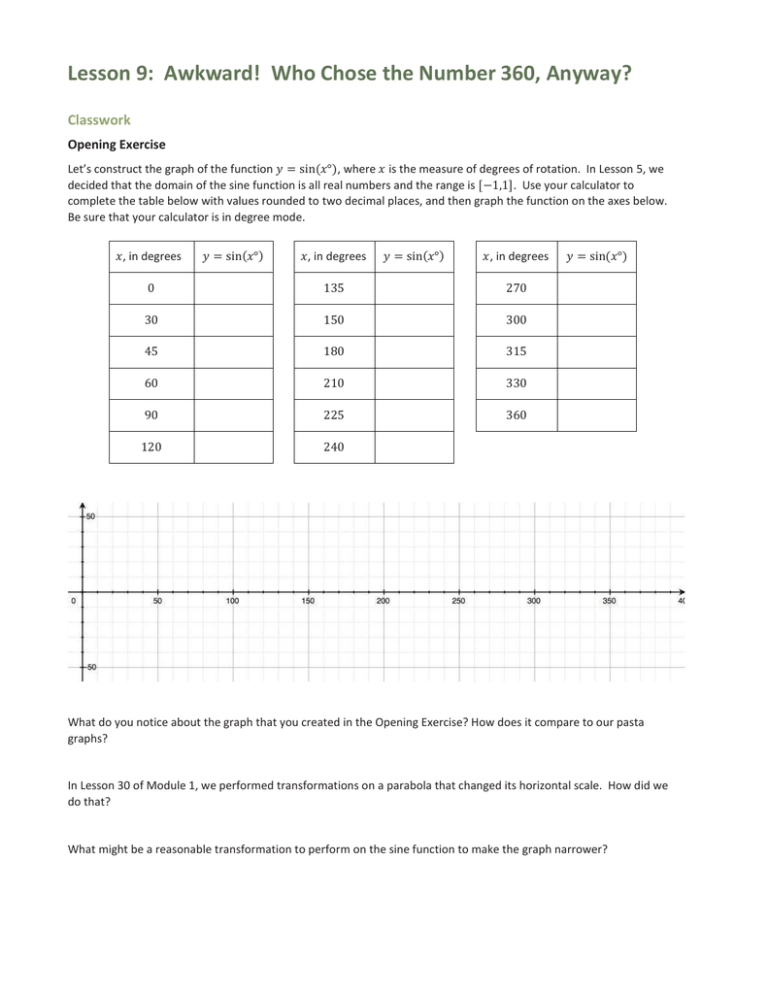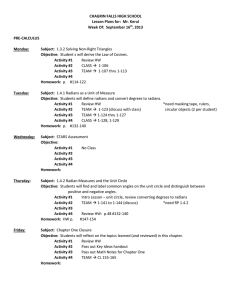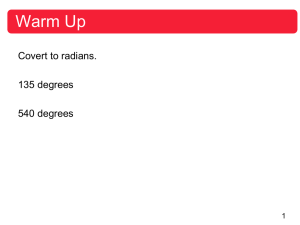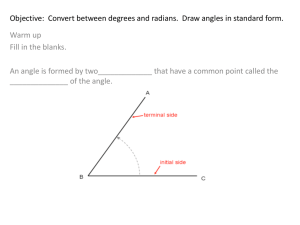Lesson 9 Notes and PS
advertisement

Lesson 9: Awkward! Who Chose the Number 360, Anyway? Classwork Opening Exercise Let’s construct the graph of the function 𝑦 = sin(𝑥°), where 𝑥 is the measure of degrees of rotation. In Lesson 5, we decided that the domain of the sine function is all real numbers and the range is [−1,1]. Use your calculator to complete the table below with values rounded to two decimal places, and then graph the function on the axes below. Be sure that your calculator is in degree mode. 𝑥, in degrees 𝑦 = sin(𝑥°) 𝑥, in degrees 𝑦 = sin(𝑥°) 𝑥, in degrees 0 135 270 30 150 300 45 180 315 60 210 330 90 225 360 120 240 𝑦 = sin(𝑥°) What do you notice about the graph that you created in the Opening Exercise? How does it compare to our pasta graphs? In Lesson 30 of Module 1, we performed transformations on a parabola that changed its horizontal scale. How did we do that? What might be a reasonable transformation to perform on the sine function to make the graph narrower? Discussion: Let’s review our basic system of measurement for rotation. We could take the entire circle as the unit of rotational measure; this is known as a turn. Then, a rotation can be expressed as a fraction of a turn. For 𝟏 𝟏 𝟒 𝟐 example, turn would correspond to a right angle, and of a turn would correspond to a straight angle. Instead, we more commonly use a small unit called a degree. We divide the circle into 𝟑𝟔𝟎 arcs of equal length, and then the central angle subtended by one of these arcs has measure 𝟏 degree. Then, a turn measures 𝟑𝟔𝟎°. Babylonians are the ones responsible for our system of measuring rotations and angles. It appears that the Babylonians subdivided the circle using the angle of an equilateral triangle as the basic unit. Since they used a base-𝟔𝟎 number system, they divided each angle of the equilateral triangle into 𝟔𝟎 smaller units, each with measure 𝟏 degree, giving 𝟑𝟔𝟎 degrees in a turn. Each degree is subdivided into 𝟔𝟎 minutes, and each minute is subdivided into 𝟔𝟎 seconds. For our purposes now, using 𝟑𝟔𝟎° in a turn is cumbersome. Instead of basing our measurement system on an arbitrary number like 𝟑𝟔𝟎, we will instead use a system in which the measures of angles and rotations are determined by the length of the corresponding arc of a unit circle. A circle is defined by a point and a radius. If we start with a circle of any radius and look at a sector of that circle with an arc length equal to the length of the radius, then the central angle of that sector is always the same size. We define a radian to be the measure of that central angle and denote it by 1 rad. Exercise 1 a. What is the arc length in terms of the radius of the circle, 𝑟, for a full rotation? b. How many radians are there in one full rotation? Thus, a radian measures how far one radius will wrap around the circle. For any circle, it takes 2𝜋 ≈ 6.3 radius lengths to wrap around the circumference. In the figure, 6 radius lengths are shown around the circle, with roughly 0.3 radius lengths left over. Definition of a Radian: The radian angle, 𝜃, created by a rotation about a point A using a radius of r and passing through an arc of length s 𝑠 is defined as 𝜃= or 𝑠 = 𝜃𝑟 𝑟 1. Use a protractor that measures angles in degrees to find an approximate degree measure for an angle with measure 1 rad. Use one of the figures from the previous page. *Radians essentially measure the total number of radii (hence the name) that have been traversed about the circumference of a circle in a given rotation. Examples 1–5 Radians are essential in the study of higher level mathematics and physics. It is important to be able to convert between the angular systems of degrees and radians. 1. Convert from degrees to radians: 45° 2. Convert from degrees to radians: 225° π rad 3 3. Convert from radians to degrees: − 4. Convert from radians to degrees: 5. We should also feel comfortable with the fact that radians do not always have to be in terms of 𝜋. Convert the following radian angles to degrees. a. 3π 4 rad 𝜃 = 5.8 b. 𝜃 = −2.5 Exercises 2-4 1. Determine the number of radians that the minute hand of a clock passes through if it has a length of 5 𝑖𝑛𝑐ℎ𝑒𝑠 and its tip travels a distance of 13 𝑖𝑛𝑐ℎ𝑒𝑠. 2. If a pendulum swings through an angle of 0.55 radians, what distance does its tip travel if it has a length of 8 𝑓𝑒𝑒𝑡? 3. On your calculator, graph the functions 𝑦 = 𝑥 and 𝑦 = sin ( the decimal approximation to the constant 180 𝜋 180 𝑥°). What do you notice near the origin? What is 𝜋 to one decimal place? Lesson Summary A radian is the measure of the central angle of a sector of a circle with arc length of one radius length. There are 2𝜋 radians in a 360° rotation, also known as a turn, so degrees are converted to radians and radians to degrees by: 2𝜋 rad = 1 turn = 360 °. SINE FUNCTION (description): The sine function, sin: ℝ → ℝ, can be defined as follows: Let 𝜃 be any real number. In the Cartesian plane, rotate the initial ray by 𝜃 radians about the origin. Intersect the resulting terminal ray with the unit circle to get a point (𝑥𝜃 , 𝑦𝜃 ). The value of sin(𝜃) is 𝑦𝜃 . COSINE FUNCTION (description): The cosine function, cos: ℝ → ℝ, can be defined as follows: Let 𝜃 be any real number. In the Cartesian plane, rotate the initial ray by 𝜃 radians about the origin. Intersect the resulting terminal ray with the unit circle to get a point (𝑥𝜃 , 𝑦𝜃 ). The value of cos(𝜃) is 𝑥𝜃 . Problem Set 1. What is the radian measure of an angle subtended by an arc of a circle with radius 4 cm if the intercepted arc has length 14 cm? How many degrees? 2. What is the radian measure of an angle formed by the minute and hour hands of a clock when the clock reads 1:30? How many degrees? (Hint: You must take into account that the hour hand is not directly on the 1.) 3. What is the radian measure of an angle formed by the minute and hour hands of a clock when the clock reads 5:45? How many degrees? 4. The distance from the equator to the North Pole is almost exactly 10,000 km. a. Roughly how many kilometers is 1 degree of latitude? b. Roughly how many kilometers is 1 radian of latitude?





